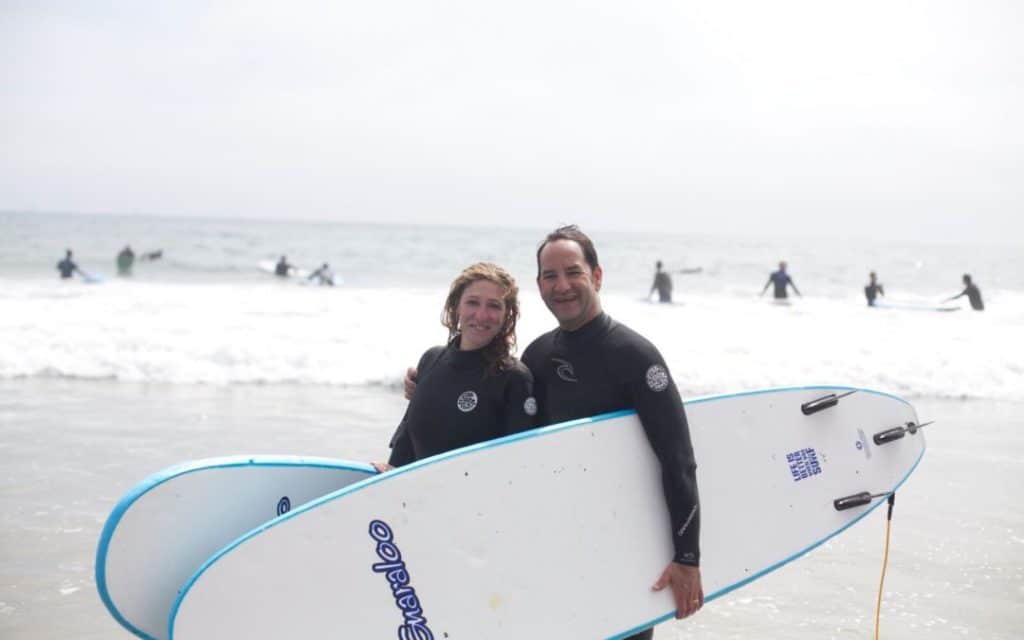Learn To Surf In Santa Barbara
The feeling of surfing a wave is indescribable to a land lover. The rush of the wind in your face and the board under your feet. Your dream to experience that wondrous feeling of gliding across a wave can easily become a reality in Santa Barbara. This post is your guide to learn to surf in Santa Barbara and beyond.
Please leave a comment below if we have missed something, or just ask a question. We love feedback!
Now let’s get started…
Why I Love Surfing
Surfing is incredibly unique. No two surf sessions are alike. I can surf alone with my thoughts, make new friends in the lineup, or I can focus on improving maneuvers. I never know how a surf session will go or where it will take me. All that is certain for me is that I can be at peace with myself where I feel truly connected with the world.
Surfing has taught me to be more caring and respectful of this world we live in… If I am being completely honest though, the best part about surfing is the pure joy of gliding down the wave. These waves come from hundreds if not thousands of miles away with no intention to be ridden. Every day I catch a wave I am thankful for this gift from the ocean. There is nothing better than surfing with friends!
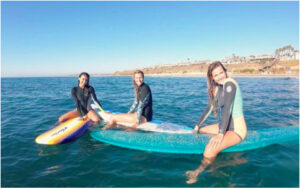
While there is competitive surfing, the vast majority of surfers are surfing simply for the love of surfing. Experience doesn’t matter; paddling into a wave and catching it gives every surfer a sense of accomplishment. When you stand up and plant your feet onto any board, you feel the energy of the wave pulse through you. There are different ways to ride a wave. You may use the power of the wave to guide your direction, or you may pick your own line along the face of the wave.
Surfers are one and the same, and nothing like each other. Surfers at the same break must work in unison to not run each other over and maintain respect for each other and the ocean. This allows each person to enjoy this joy of surfing together as individuals. We are all getting something from surfing, but what do you want from learning to surf?
What Is Your Goal?
Understanding your motivation for learning to surf will help you make certain decisions early about how to best get into the water.
If you are on vacation in California, then coming to Santa Barbara to learn to surf is 100% the route to take. You will be guaranteed to catch and ride more waves by taking a surf lesson. If you are truly dedicated to becoming someone that surfs on a weekly basis, then getting your own board and suit will be necessary, but you don’t need to buy them right away.
Learning to surf in Santa Barbara with our private instructors is a great way to increase your understanding of the basics of surfing. Once you’ve gotten your feet wet a few times, then you can think more about making those purchases.
Like most new skill-based activities, learning to surf takes practice between your lessons. Building muscle memory and increasing endurance will progress your surfing ability steadily. Some beginners can excel quickly while others have a more slow increase in surfing development. We all go at our own pace. If you pick it up relatively quickly, one lesson might be all that you need! The foundation of skills will build upon itself, so creating a strong base will lend itself to better surfing in the future.
Is Surfing Hard?
Many people often ask us if surfing is difficult; the short answer is yes, but this depends on a variety of factors. Physical fitness and flexibility play a key role in a beginner’s ability to progress. More stamina means more practice in the water. Stretching will also help your body prepare and recover from surf sessions.
Another important part about surfing is being comfortable swimming in the ocean! The ocean is unpredictable. If you have previous experience swimming or being in the ocean, you will feel much more comfortable on a surfboard and able to progress more quickly.
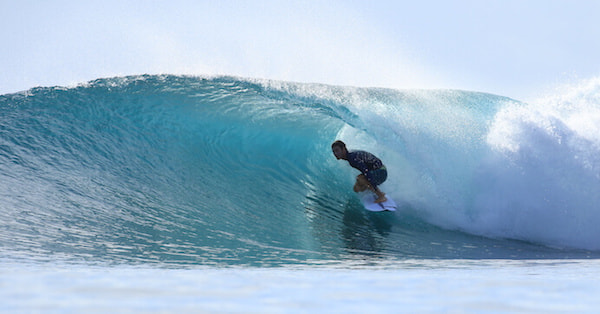
If you don’t have any experience in the ocean or are somewhat scared of waves, I recommend taking a few smaller steps before trying surfing. Swimming around in the surf can offer a great experience with waves and help you understand how the ocean works. Diving under waves or letting them break on you will also help give you confidence in how you will react underwater during stress. Know your limits and only do this if you feel comfortable.
Body surfing is perfect to try after you feel more comfortable in the waves. Body surfing is the act of catching and riding a wave on your stomach with no board at all!
So if you can swim, are in good shape, and are comfortable in the ocean, then learning to surf can be fairly straightforward. If you need to work on some of these focus points then it might take you a little longer to get comfortable, but that doesn’t mean you can’t learn! Patience goes hand-in-hand with surfing. Accepting the fact that you will be bad at surfing when you begin allows you to laugh at your wipeouts and have fun when you look silly.
Safety Considerations When Learning To Surf In Santa Barbara
There are numerous safety considerations to think about before getting into the water. All of the potential dangers can be mitigated through some common sense. Many people think that sharks are the biggest danger to surfers in the water. This is simply not factual. Yes, sharks live in the ocean and we are surfing in their home, but shark attacks are few and far between. The most common hazards if you learn to surf in Santa Barbara are other surfers, yourself, and stingrays.
Other Surfers:
You are statistically more likely to be injured by the other surfers in the water. The risks associated with other surfers are related to overcrowding, surfers not wearing a leash, and other beginners who do not have the skills to navigate a busy lineup. I recommend leading by example wearing a leash, avoiding overcrowded surf spots when possible, and gaining more experience in the water. Always be vigilant of your surroundings. If you see somebody that appears out of control or inexperienced, then try and give them some distance. See the photo below of a lineup that is about to be caught inside, and way too close to each other!
You:
Number two on the list is all about you! This sounds silly that you are a top hazard for yourself, but beginners often make mistakes that get them in trouble. Know your limits regarding surf size and conditions. When in doubt, don’t paddle out.
When you are finished riding a wave, make sure you do not dive headfirst into shallow water. The best dismount, while not graceful, is jumping feet first at an angle, with limp legs and “crumble” into the water. By doing this you are reducing the risk of rolling an ankle in water that is more shallow than you think. Even falling more flat on your back or stomach into the water can be a great option.
Make sure to cover your head when standing up. The surfboard may be directly above you when you come up from underwater. When in trouble the surfboard will also help you stay afloat, so having a leash will keep it close to you.
Last but not least; don’t panic. If you are in Santa Barbara and learn to surf, you will most likely be in water that is less than 5 feet deep, so standing up is always a great way to prevent drowning! If you get pushed or fall underwater, try to relax.
You can hold your breath much longer than you think. When we panic, our bodies want to fight for oxygen before we truly need it. Your body’s response to not breathing is to breathe! Try and clear your mind and count to 10. Most people are capable of holding their breath much longer, but a hold-down is rarely longer than 10 seconds.
Stingrays:
This is the most unpredictable hazard that you may run into when you learn to surf in Santa Barbara. Stingrays are a flatfish that skim and lay on the seafloor near breaking waves in warmer waters. They have an incredible defense mechanism on their tail; a barb that they swing up in self-defense when stepped on.
Always always always practice the “stingray shuffle” when walking in the water. This is sliding your feet along the seafloor while walking in the ocean. This will be giving the rays a heads up you are coming, allowing them to swim away before you get to them. If by chance you brush up against their sides, they will usually swim away instead of sticking you! They aren’t aggressive, but wouldn’t you be angry if someone stepped on top of you?
Now that the safety precautions have been gone through, I can tell you about surfing gear.
What Kind of Equipment Do I Need?
There are only three main pieces of equipment that you will need for surfing; wetsuit, surfboard, and a leash. The leash is the most important part of a surfer’s gear to ensure the safety of yourself and others. When a surfer falls or loses control of their surfboard, it may be pushed by the wave towards other surfers. By wearing a 6’-8’ leash connected to your ankle, you will be minimizing the possibility of the board hitting other surfers.
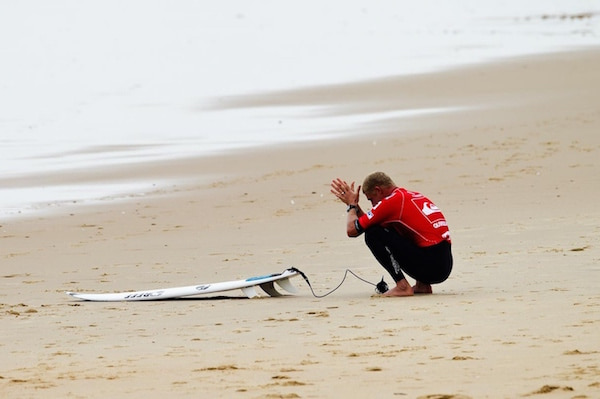
Buying quality equipment is important. You don’t need to buy the highest quality, but you should never buy the cheapest items. Buying cheap lends itself to spending more money in the future on repairs or even brand new gear sooner because they don’t hold up against standard use. Wear and tear will happen on any surfboard, leash, and wetsuit. You should always check your equipment before getting in the water to make sure your fins and leash are secured.
Wetsuit
The wetsuit will keep you warm and comfortable in the water, so finding the right fit and thickness is important. There are so many brands of wetsuits that finding the perfect wetsuit for yourself has never been easier, AND more difficult. So many options!
The best advice on buying a wetsuit is to go to a local surf shop and try a few different brands. Find a suit that is snug, comfortable, and allows flexibility. Extending your arms and squatting will help you feel if there are tight spots in the legs or shoulders. You will be in cold water for extended periods of time, so being in love with your wetsuit will keep you smiling and catching waves for hours.
Remember to pay attention to wetsuit thickness because California has a wide variety of water temperatures along the coast. Here is a basic guide to help you decide on what thickness wetsuit you may need:
- 48F – 54F – 5/4/3mm with booties, gloves, and a hood
- 55F – 62F – 4/3mm with booties
- 62F – 70F – 3/2mm – 2/2mm
- 70F+ – .5mm 1mm if needed
Each person’s blood circulation and body type will change their wetsuit needs. Furthermore, booties, gloves, and a hood are often a personal preference.
I only wear booties in temperatures under 56F or so and only wear a hood on colder mornings with the wind. I’ve don’t need gloves when I am in California. If you consider yourself a person that gets cold easily, then I recommend booties if you learn to surf north of Santa Barbara county.
Surfboard
The surfboard is going to become a part of you as an extension of your body, so it should be picked out specifically for you. This doesn’t mean you need an expensive custom board. Your first board should be a longboard sized relative to your height and weight. A beginner’s surfboard should always be a soft top for the safety of the beginner, as well as the other people enjoying the ocean nearby. Many injuries from surfing happen because of loose boards.
SurfTech has a wide variety of soft-top longboard options that are built for beginners. The L2S is my favorite for beginners and comes in sizes from 7’6” – 12’, making it easy to find the right size. The best part about these SurfTech boards is they can also be ridden by more experienced surfers because they are of a higher quality than other foam surfboards.
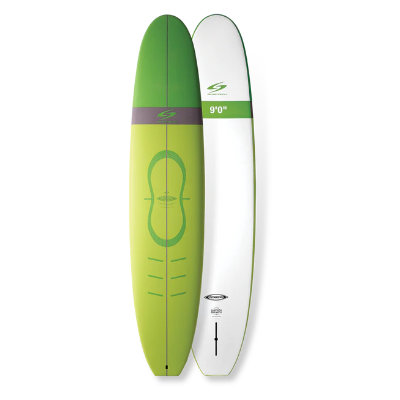
After I would teach a surf lesson would often take an 8’0” SurfTech out for a few waves afterward. I’ve been surfing (competently) for over 10 years, and I still have an absolute blast on them.
Where Do I Start?
Location, Location, Location. It’s not just about property values! Picking a surf spot to learn is crucial to having a good first experience. Surf Spots such as Steamer Lane in Santa Cruz, Rincon Point in Santa Barbara, or Trestles in Orange County are world-class surf breaks. These are NOT surf spots for beginners that are just learning the ropes.
Cowell’s, Mondos Beach, and San Onofre are all nearby the respective surf breaks above but are much more beginner-friendly. A beginner-friendly wave will make a new surfer’s first time more memorable and enjoyable.
The ideal surf break to learn is where a wave breaks gently and over a long distance, such as the point break at Mondos Beach. That’s why most people who learn to surf in Santa Barbara are taught at Mondos Beach. This wave breaks down a long right-handed point break and can often produce rides over 100 yards, even for beginners! When the swell is pumping this wave can be ridden in excess of 300 yards for a more experienced surfer.
Kinds of Surf Breaks:
Point breaks:
Point breaks are waves that break along a piece of land that sticks out into the ocean a little further than the rest of the coast. This creates a consistently breaking wave that will typically produce longer rides with more variation throughout the wave. Point breaks are typically exclusively uni-directional; meaning they only break to the left or to the right.
Beach Break:
Beach breaks will break closer to shore and their shape relies on the sandbars that form on the seafloor. Spots like this can shift from day to day and over the seasons. Beach breaks are optimal if you want to find your own peak to surf when there are still others surfing. These waves aren’t usually long rides such as a point break might produce. They still can offer very fun waves that anyone can enjoy.
Reef Break:
A reef can be either rock or coral and acts similarly to point breaks. Underwater rock or coral provides a consistent underwater feature that the waves break up. These waves are fairly predictable, such as Cloudbreak in Fiji, which offers picturesque barreling waves on any swell. They will often break in only one direction, but some reef breaks offer two directions.
Surfing Culture
There are many unofficial rules of surfing that you should try to understand before surfing around other experienced surfers. You may think that you will be able to paddle out to any surf spot and catch waves. If you are the sole person out surfing, then you will absolutely catch a few fun waves. However, if you try to paddle out in a spot with 50+ people, you will struggle to find the right place to wait for the waves and get frustrated. Surfing culture means different things for different people.
Wave Watching/Mind Surfing
Something invaluable that I learned early on in my surf career was to watch the waves and the surfers that are already riding them. There are three things to pay close attention to when watching a break; where is the wave breaking consistently, what are the surfers doing to maintain position, and what are the potential hazards.
Most surf breaks will have a “takeoff spot.” By watching the waves for 10-30 minutes you should be able to see a pattern about how it tends to break. No spot will break exactly the same every time. Kelly Slater’s Surf Ranch has one of the only consistently perfect waves every time.
Tied into the takeoff spot is where the surfers are waiting patiently for their next wave. They will often not sit right where the wave breaks, and instead, will be slight to the side and/or further out. They want to catch the wave before it breaks, and lining up to the side/further out allows for a hierarchy of who gets the next wave to be established.
Etiquette
Surfing Etiquette is a tricky subject because of the local culture changes in different places. Reading and learning about basic surf etiquette prior to learning to surf will help you become a better surfer, as well as gain similar respect in the lineup. Here are some tips that will help you get into the water in a safe and friendly way.
Basic Water Etiquette
-
Surf Spots That Match Your Ability:
By watching the surfers in the lineup, you should be able to get a feel for the spot. If the majority of surfers are on shortboards or if you don’t see any soft-top surfboards, this spot is most likely advanced surfers only. Most surf spots also have nearby waves that better match the waves that you are looking for, so take your time in deciding where to paddle out.
Dropping in is the act of catching a wave after someone has already caught the wave and you take off in front of them. Always look both ways before, during, and after catching a wave because you might not have seen someone!
https://www.instagram.com/p/BeJdAWxlKfw/?igshid=1xdwz3fn18lga
Don’t Snake:
A snake is someone who will paddle around people into a priority position that puts you in a spot that technically makes you drop in on them. Trying to justify dropping in on someone for snaking/back paddling someone is hard. Snaking someone is one of the worst things to do in the lineup, so try your best to respect who is already in position for the wave.
-
Paddle Around:
Paddle around the breaking waves because this is where the surfers really want their space to move on the wave. They don’t want to worry about other people paddling out. There is typically a channel, or a spot next to the waves, that does not have breaking waves. Paddling out in the channel is easier and safer for everyone. Watching the waves before you paddle out will help you identify where the channel might be at each surf break.
-
Take Turns:
After taking a great wave or two, I highly recommend letting the next one go to someone else. By sharing waves with others you will be demonstrating that you are there to have friendly fun instead of selfishly catching every wave you can. Maybe the person you let get a wave will give you one later in the session!
-
Respect The Locals:
I cannot stress the number 6 enough. There has been an unprecedented rise in the number of surfers around the world in the past few years. The rise in surfers in the water has made some long-time surfers upset that new inexperienced surfers are coming to their local spots and not respecting their locality. Allow locals to have the first pick of waves and slowly work your way into the lineup instead of paddling straight to the takeoff point.
This is another reason why Mondos Beach is a perfect spot to learn to surf in Santa Barbara. The people in the water at Mondos are expecting inexperienced surfers, so they sometimes will offer pointers and help to first-timers. Locals here understand the wave is best for beginners. They aren’t surfing Mondos to become professionals, they are just there to have some fun!
-
Apologize:
Oh no! You accidentally dropped in on someone. That’s ok! Pull off the wave as soon and safely as you can and apologize. “Hey sorry about that, didn’t see you” can go a long way. We all make mistakes in our surfing careers so don’t sweat a mistake here or there. The worst mistakes are the ones that put others in danger, so being safe and aware of your surroundings will help prevent mistakes.
Part of the learning experience of surfing, especially somewhere in Santa Barbara where you will undoubtedly surf with others, is figuring out how to navigate the lineup. This takes time so be patient with yourself and others.
-
Help A Surfer In Need:
It doesn’t matter if they just dropped in on you, yelled at you because you made a mistake, or are your arch-nemesis, help your fellow surfers. We all share a love for the ocean and a death among us hurts all of us. If someone is injured or appears distressed, don’t hesitate to help them in any way.
-
Leave No Trace:
I hate pulling up to a local surf spot and finding the parking lot littered with trash, old wax, or any other sign of disrespect. Treat your surf spots like a work friend’s house you are visiting for a dinner party; clean up after yourself and at least offer to do the dishes!
-
HAVE FUN:
Nobody likes a grumpy person in the lineup. Surfing is about having fun. When one person isn’t having fun then other people start to feel the same way. Relax, enjoy the waves, and remember to smile at others!
The basic rule of thumb for going into the water anywhere new is to respect the local surfers, and not be in the path of others. This is easier said than done and you will make plenty of mistakes. The best thing to do is to be apologetic and learn from these mishappenings to avoid similar mistakes in the future.
I Think I’m Ready To Get In The Water!
You might be asking yourself, “why don’t I just rent a surfboard and learn by doing?” This is a common thought process for many first time surfers. For some people, this option is most logical because of where they live or where they want to go surfing. There’s no doubt that renting a surfboard would be less expensive initially, but renting multiple times long term would add up quickly. You would be missing out on so much information without an instructor teaching you one-on-one.
Your private surf instructor should help you learn and develop correct paddling technique, wave selection, and etiquette in a one-on-one setting. Learn to surf in Santa Barbara from a World Surf League accredited surf school, and we will give you a more memorable experience than a rental!
Cal Coast Adventures
Cal Coast Adventures has been a premier surf school for beginners learning in Santa Barbara for many years. As an accredited surf school by the World Surf League, you can rest assured that when you learn from us in Santa Barbara, we will provide the highest quality instructors and equipment. Our surf instructors have extensive knowledge of the waves in the area.
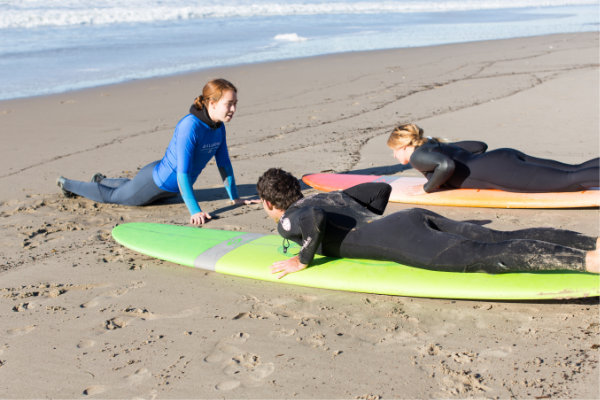
We recommend Ventura’s Mondos Beach for learning to surf in the summer. The waves down there tend to be more fun and consistent than the waves in Santa Barbara proper in the summer. The instructors’ goal is that your experience in Santa Barbara while learning to surf will be a memorable experience. When you learn to surf at Cal Coast Adventures, we will provide you with the knowledge that enables your surfing skills to progress beyond your first session in Santa Barbara.
Learn To Surf In Santa Barbara With Cal Coast Adventures
Learning to surf with us in Santa Barbara will teach you foundational surfing strategies that will allow you to propel yourself into a lifelong career of surfing. You will learn about ocean safety, basic surf forecasting, how and where to paddle, how to paddle through waves, and surfing etiquette.
We will teach you how to identify waves, when to paddle, paddling techniques, and of course, how to surf! Lessons are 1.5 hours, and we guarantee a full hour in the water after beach safety and dry sand instruction. This allows you to learn at your own pace without being rushed.
Learning to surf with Cal Coast Adventures is not just about being pushed into waves and standing up. We pride ourselves in providing instructors who can answer all of your questions about learning to surf in Santa Barbara. You will be pushed into waves, but we will gradually help coach you into paddling and catching your own waves so that you can successfully transition into surfing unassisted!
Most of our instructors grew up in the area, which means they can also give you local knowledge about the Central Coast. Just ask them for any kind of information you want to know!
Do I Need To Bring My Own Board and Wetsuit?
We have a wide selection of surfboards suitable for all sizes and ability levels included in the lesson. Wetsuits are included and selected based on individuals’ height and weight to ensure you are comfortable and warm. We try to make the learn to surf experience as easy and hassle-free as possible in Santa Barbara so you can get in the water sooner! We teach people aged 5-75, depending on ability and comfort level. If you are visiting Santa Barbara and decided to learn to surf with us, we do require all students to be healthy and able to swim.
Lessons come with all the equipment that you will need:
- Surfboards
- Wetsuits
- Leash
If you have your own wetsuit or board, just let us know!
While we provide the necessities for getting in the water and surfing, there are a few other things that you should bring. Always have water with you any time you go surfing. The sun and sea-water will dehydrate you quickly, so having a bottle of water will help you re-hydrate. I often forget to drink water because I am having too much fun! Once you get more experienced, you might want to pick up some other surfing accessories.
Sunscreen is crucial. Santa Barbara has over 300 days of sunshine each year on average and sunburns can hinder the rest of your vacation. Make sure to find environmentally safe sunscreen that won’t damage our local ecosystem. I also recommend bringing a granola bar for a pre-surf snack. Learning to surf can be exhausting; your arms hurt from catching so many waves, and your face hurts from smiling, so grab a bite to eat in Santa Barbara to refuel and recoup for your next surfing experience.
Do I Need Ocean Experience Before Learning To Surf In Santa Barbara?
Most of the clients that sign up for lessons are complete beginners. Many clients have never even been to the ocean! Lessons are privately taught to give you a high level of safety and in-depth instruction, all at your own pace.
Picking The Right Lesson For You
Each person or group that wants to learn to surf will be unique, so we have a wide variety of options to make your Santa Barbara experience personalized. You will have your very own private instructor(s), depending on your group size. We never put strangers together, so your group will always know each other.
For less than $100 you can be out surfing in a fun and safe environment with a professional instructor teaching you the tricks of the trade.
Rent A Board For The Day
We also offer daily rentals! We have a wide variety of longboards and soft-tops, as well as a few epoxy/fiberglass boards. With a great choice of soft or hard top surfboards, and a small line of epoxy/fiberglass boards you are sure to find something that fits your needs. Communicate with us what your ability level is and what kind of surfing you enjoy so we can get you set up with the perfect board for you.
Final Thoughts on Learning to Surf In Santa Barbara
As you have read, surfing is a dynamic activity that offers many different options for getting into the water. There is nothing more classic than visiting Santa Barbara to learn to surf while on vacation in California. The Santa Barbara area is a perfect place to make your dream of surfing become a reality. If you are looking for a classic Santa Barbara experience, then come learn to surf with Cal Coast Adventures. Cal Coast Adventures of Santa Barbara will have you out in the water learning to surf in no time.
